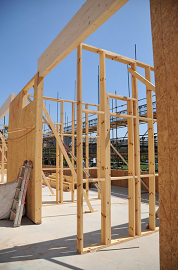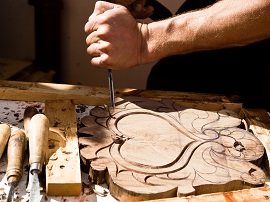Softwood
Softwood is a type of wood that is cut from trees belonging to gymnosperms, such as coniferous trees. By contrast, hardwood typically comes from angiosperm, deciduous and broad-leaved trees. Trees that lose their leaves in the autumn, such as oak.

|

|
| Softwood | Hardwood |
Softwood trees, such as pine, cedar, spruce, larch and fir, retain their leaves throughout the year and grow faster than hardwood.
Unlike hardwood, the microstructure of softwood trees does not include vessels, as their cells are open. This allows them to act as conduits, feeding nutrients and water through the tree. These open cells allow them to absorb things such as adhesives and finishes better.
Softwood provides around 80% of all timber, and is usually supplied in long, rectangular forms such as planks, posts and rails. Softwood is commonly used in construction, in the roof and inner walls structures, as well as in other building components such as fixtures and fittings, doors, and so on. It is also the main constituent of some man-made boards, such as medium density fibreboard.
Hardwood is typically used in furniture such as tables, chairs, chest drawers, and so on. It may also be used in applications such as window frames.
Though some softwoods are harder than hardwood (for example, balsa is a hardwood), softwood is generally less dense. This makes it easier to saw, plane, bore, nail, and so on.
[edit] Related articles on Designing Buildings Wiki
- 11 things you didn't know about wood.
- Bamboo.
- Cedar.
- Cross-laminated timber.
- Decking boards.
- Glulam.
- Hardwood.
- Janka hardness rating scale.
- Lime wood.
- Laminated veneer lumber LVL.
- Panelling.
- Physical Properties of Wood.
- Pine leaves.
- Pine wood.
- Plywood.
- Sustainable materials.
- Testing timber.
- The differences between hardwood and softwood.
- Timber.
- Timber preservation.
- Timber vs wood.
- Types of timber.
- Walnut.
- Wrot timber.
Featured articles and news
Professional practical experience for Architects in training
The long process to transform the nature of education and professional practical experience in the Architecture profession following recent reports.
A people-first approach to retrofit
Moving away from the destructive paradigm of fabric-first.
International Electrician Day, 10 June 2025
Celebrating the role of electrical engineers from André-Marie Amperè, today and for the future.
New guide for clients launched at Houses of Parliament
'There has never been a more important time for clients to step up and ...ask the right questions'
The impact of recycled slate tiles
Innovation across the decades.
EPC changes for existing buildings
Changes and their context as the new RdSAP methodology comes into use from 15 June.
Skills England publishes Sector skills needs assessments
Priority areas relating to the built environment highlighted and described in brief.
BSRIA HVAC Market Watch - May 2025 Edition
Heat Pump Market Outlook: Policy, Performance & Refrigerant Trends for 2025–2028.
Committing to EDI in construction with CIOB
Built Environment professional bodies deepen commitment to EDI with two new signatories: CIAT and CICES.
Government Grenfell progress report at a glance
Line by line recomendation overview, with links to more details.
An engaging and lively review of his professional life.
Sustainable heating for listed buildings
A problem that needs to be approached intelligently.
50th Golden anniversary ECA Edmundson apprentice award
Deadline for entries has been extended to Friday 27 June, so don't miss out!
CIAT at the London Festival of Architecture
Designing for Everyone: Breaking Barriers in Inclusive Architecture.
Mixed reactions to apprenticeship and skills reform 2025
A 'welcome shift' for some and a 'backwards step' for others.





















